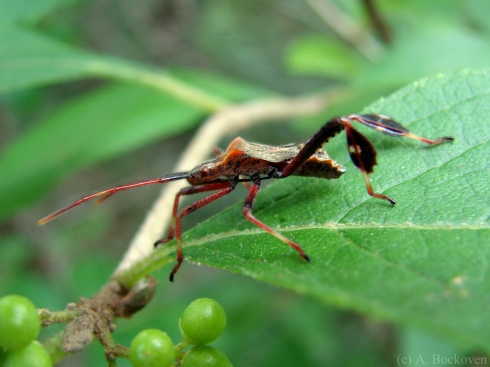Look at the picture above and the one below. You may notice a resemblance to some of the insects I’ve talked about in my most recent posts. However, despite their similar appearance these bugs are actually two different types of insects from two very different families. The insect above is an herbivorous leaf-footed bug (Coreidae), while the bug below is a carnivorous assassin bug (Reduviidae). In fact, many leaf-footed bugs and assassin bugs in the field bear a striking resemblance to each other.

Assassin bug peering over a leaf (Reduviidae). The stridulatory groove can be observed on the prosternum.
How to tell them apart? Those same sucking mouthparts that classify them both as hemipterans. These beaks, or rostrums, may both be designed for sucking fluids but they also tell us something about the kind of food each bug eats. Leaf-footed bugs, and other coreids are exclusively plant eaters. Assassin bugs and other reduviids are exclusively predators. As a rule of thumb, the beaks of herbivorous insects are longer than those of carnivores. This is because most herbivorous insects need to pierce deep down into the tissue of plants to reach the sticky sap. Predatory insects, on the other hand, have short stabbing knives of beaks to quickly pierce their prey and inject toxic digestive chemicals.
As you can see, the leaf-footed bug in the first picture has a beak reach most of the way down it’s body. The beak of the assassin bug in the second picture is much shorter. In fact, among reduviids this beak is the most diagnostic trait for identification. The beaks of reduviids tuck under their heads and fit into a small notch in their sternum, or chest, called a stridulatory groove. Reduviids can rub their beaks across the rough surface inside this groove to create a rasping noise (stridulation) to warn off predators.





Recent Comments